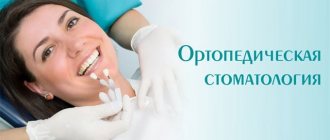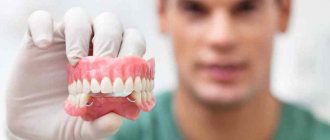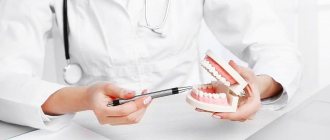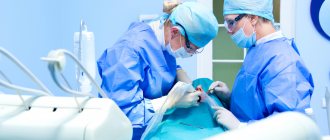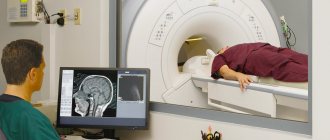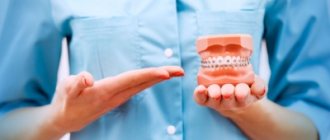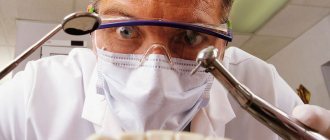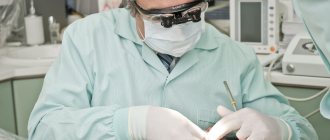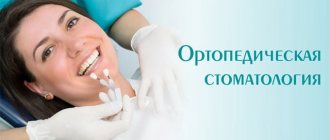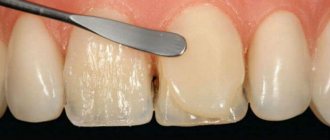Today, orthopedic doctors have modern materials and technologies that make it possible to restore damaged teeth to their natural appearance and maintain their health for many years. However, despite the important role of orthopedics in dental practice, it should be noted that when restoring damaged teeth and correcting jaw anomalies, the condition of the whole organism must be taken into account. The fact is that pathological processes in the oral cavity are often associated not only with external factors, but also with disruption of the functioning of internal organs. For example, insufficient nutrition of the tooth and surrounding tissues may be due to the presence of diseases of the gastrointestinal tract. Conversely, poor quality chewing leads to digestive problems. Therefore, without an integrated approach, orthopedic treatment may be ineffective.
How is the appointment going?
At the first appointment, the orthopedic doctor collects all the necessary data - asks the patient about complaints and expectations, does a CT scan and examines the oral cavity.
Next, the doctor analyzes the data obtained and offers treatment options, calculating the budget for the work to be done.
And at every appointment, you can watch a movie on the screen and have a good time instead of focusing on the sensations in your mouth.
- Symptoms and conditions requiring consultation with an orthopedic dentist
- Microprosthetics: correction of minor defects
- Removable prosthetics: classics
- Fixed prosthetics: long-term treatment of insufficient dentition
- Implantation is a modern dental orthopedics service
- Appointment with an orthopedic dentist: features
- Equipment and materials used in orthopedic dentistry
- Orthodontist or orthopedist: so as not to be confused
- The best orthopedic dentists in Moscow
Among dentists there are also highly specialized specialists. When it comes to saving the integrity of the dentition or restoring it, an orthopedic dentist comes to the rescue. After all, not all patients really realize that the oral cavity requires constant attention, competent care and timely treatment. And after N number of days, weeks, months, years, the moment comes when they go to the clinic in the hope of getting rid of problems through the use of conservative medicine methods. But they are referred to this specialized specialist. The latter gives, although artificial, a new and beautiful smile, the opportunity to use teeth for their intended purpose, using the capabilities of a dental laboratory.
Bibliography
- Bogdan V. E. et al. Prevention of dental anomalies and orthodontic treatment at an early age // Chief Doctor of the South of Russia. - 2013. - No. 6 (37). — P. 4-6
- Kyzina S. L., Rebrova A. E. Orthodontics for everyone // Healthcare of Ugra: experience and innovations. — 2022. — No. 4. — P. 33-38
- Tokarevich I.V. General orthodontics // Educational method. allowance. — Minsk: BSMU. - 2015. - 80 p.
- Khotayt A. Kh., Butvilovsky A. V. Method of manufacturing a non-removable individual retainer // Orthodontics gnathology. — 2022. — November. — No. 2 (3). — P. 22-26
- Kipkaeva L. V., Belkevich V. V. Application of the aligner system in the treatment of dentofacial anomalies in the permanent dentition. Design features. Treatment effectiveness // Orthodontics gnathology. — 2021. — April. — No. 1 (4). — P. 50-55
- Bulgakova A.I. et al. Structure and equipment of dental organizations // Textbook. - Ufa: Publishing house of the Federal State Budgetary Educational Institution of Higher Education BSMU of the Ministry of Health of Russia. - 2016. - 84 p.
- Ganjali N. T. Braces or aligners? // Bulletin of medical Internet conferences. — 2014. — T. 4. — No. 4. — P. 370
- William R. Proffitt et al. Modern orthodontics // Textbook. — 686 p.
- Demina M.A. Positive and negative aspects of working with orthodontic structures, selection criteria // Bulletin of medical Internet conferences. - 2022. - T. 7. - No. 9. - P. 1440-1442
- Alimirzoev F.A. Modern ideas about complex treatment in orthodontics // Achievements of university science. — 2014
- Shkavro T.K., Pavlova I.A. Orthodontic devices // Textbook. – Irkutsk: IGMU. — 2022. — 32 p.
Symptoms and conditions requiring consultation with an orthopedic dentist
A visit to a doctor in this specialty is important when:
- absence of teeth, regardless of the number (one or all);
- complete or partial destruction of dental units;
- increased tooth mobility;
- cosmetic defects of dental units;
- suspected or established pathology of the temporomandibular joint;
- recommendations from a general or other specialized dentist.
An orthopedic dentist in Moscow helps people experiencing both physical and psychological discomfort associated with problems with the integrity, size, shape and color of the dentition. It can relieve pain, discomfort during chewing and talking, help get rid of speech problems, make a person more attractive, etc. The work of this specialist cannot be overestimated.
Who is an orthodontist and does he install braces?
Doctors who eliminate defects in the dentofacial apparatus and correct the position of teeth are called orthodontists. Such a doctor corrects interdental gaps, crooked teeth, incorrect jaw position and much more. In his work, an orthodontist uses braces, plates and other devices that eliminate bite defects.
Orthodontists began to appear in Russia back in the Soviet years. If in those days dentists corrected defects solely according to indications, then in new Russia orthodontic treatment is increasingly used for aesthetic purposes.
The problems with which patients come to the orthodontist are divided into three categories:
- Congenital pathologies associated with underdeveloped teeth, their absence or irregular shape.
- Genetic inheritance, which leads to malocclusion, crowded teeth, large interdental spaces.
- Defects acquired during life, for example, these include crooked front teeth.
Microprosthetics: correction of minor defects
Chips, cracks, unsightly enamel color, cavities that cannot be helped by a filling - all these problems can be solved using the following designs:
- Veneers. They are thin plates that are placed on the front surface of the incisors. Their main function is to make the patient look more presentable and hide imperfections in the smile area.
- Lumineers. In essence, they are no different from veneers. However, they are inferior in thickness, are more fragile, and not everything can be hidden from the eyes of strangers. One of the advantages is that installation is possible without preliminary grinding of the tooth.
- Tabs, overlays (inlay, overlay). They are used instead of fillings, have a longer service life, and are made of ceramics with improved performance characteristics.
The best orthopedic dentists in Moscow try to focus on microprosthetics options in their practice. This is a more modern way to maintain the attractiveness of your smile.
Removable prosthetics: classics
“False jaws” is the first association that arises in patients when they mention orthopedic dentistry. Just a couple of decades ago, such constructions were practically the only chance for those who, due to age, injury or congenital pathology, were left without teeth (completely or partially).
Removable dentures consist of a base (base) on which artificial dental units are attached. They are secured in the oral cavity using special locks or hooks or a vacuum if the patient has no teeth at all.
Why are removable dentures still in demand among patients:
- They allow you to “survive” the period while preparations are underway for another type of prosthetics, that is, they are used as a temporary treatment option.
- They are affordable financially, which is why they are most often ordered and worn by older people.
- They are an alternative to implantation if there are contraindications to it.
- They can be put on and taken off independently, which makes it possible to control your edentulous problem without the help of a doctor, at home.
Fixed prosthetics: long-term treatment of insufficient dentition
Dental orthopedics in Moscow provides another type of service - it allows you to imitate a tooth or several using an artificial crown or “bridge”. Such prostheses are non-removable structures.
Crowns are caps. They are placed on the area of a pre-existing or severely damaged natural crown and held there using special cement or chemical adhesion to tooth tissues. These structures are ceramic, plastic, made of zirconium dioxide, ceramic composite and other materials. Can last for decades.
If a patient is missing several teeth in a row, the dentist may offer a solution to the problem such as installing a bridge. This way you can replace 1–3 chewing units or up to 4 front ones. It is not rational to make longer dentures. The load on the supporting teeth will be too high.
Implantation is a modern dental orthopedics service
The implant is a titanium rod that is designed to be implanted into the jaw bone tissue. It serves as the basis for artificial crowns. Such structures are the most natural, reliable and durable replacement for “native” teeth.
Implants do not need to be removed at night, from root to tip they look like natural units of the dentition, they can be installed both with the loss of 1-2 incisors, premolars or molars, and with complete edentia. This type of prosthetics allows you to feel comfortable both physically and psychologically. Mounted on titanium rods, the new jaw will not fall out during a conversation, will not rub, and does not require the use of fixing creams at home.
Read also
What are clasp dentures for teeth and which ones are better?
Dental restoration using clasp dentures is one of the most popular and budget methods.
Removable dentures: which ones are better?
Dental restoration using removable dentures can be an alternative to fixed structures.
Appointment with an orthopedic dentist: features
It all starts with interviewing the patient, listening to his complaints and reasons for visiting the doctor’s office in this specialty. Then the latter proceeds to examine the patient’s oral cavity, its problem area, in order to assess the “scale of the disaster” and understand which prosthetic methods will be most appropriate in this clinical case. To ensure that the orthopedic design fully suits the client of the clinic, serves him for a long time and does not harm him, the doctor prescribes diagnostic procedures for him, in particular x-rays, computed tomography, odontoparodontogram, etc.
If necessary, the oral cavity is sanitized, caries and other diseases are treated. Next, the orthopedic dentist, if necessary, installs stump pin inlays, grinds, makes an impression of the jaw, installs a temporary and then a permanent structure after its fitting and adjustment.
Treatment plan
We decided to visit our clinic; our doctors are always happy to help. You will have to visit the doctor more than once, you will need to be prepared for this. Initially, the patient undergoes a preliminary examination to determine the overall picture. After a preventive examination, if serious problems are detected, you need to undergo diagnostic tomography or radiography. In order for the patient to understand what he will have to face, you need to pay attention to the main list of procedures:
- Consultation and decision on choosing a method to eliminate the found defect;
- Preparatory procedures for prosthetics;
- Manufacturing and installation of prostheses;
- Assessment of the oral cavity after the procedure, observation.
Equipment and materials used in orthopedic dentistry
A dental unit, furniture, and a set of tools are only the required minimum part of the equipment of a prosthetist’s office. This specialist will also not be able to do without:
- plaster and other impression materials;
- anesthetics;
- means that control the closure of the dentition;
- fixing materials;
- antiseptics.
Today computer technologies also come to the aid of the prosthetist. In order not to grind off excess, to make a crown, “bridge” or other structure that is as close as possible in appearance to natural teeth, to save time, and not to install a core inlay, modern dentists resort to CEREC technology. It allows you to perform prosthetics in one day. The Cerek complex is equipped with a special scanning device that transmits information to a computer, where it is analyzed. Then the CAD/CAM system software complex creates a three-dimensional model of the future structure and launches the mechanisms that produce it.
Orthodontist or orthopedist: so as not to be confused
Dentists are different. There are those who deal only with the treatment of caries and its consequences, inflammation, and those who care about the health of the patient’s gums. Surely everyone knows those who remove teeth, cysts, open abscesses, etc. Among the specialized dental specialists there are also those who correct bites and align dental units. This dentist is called an orthodontist. It is he who is most often confused with an orthopedic dentist. The latter, although it straightens teeth, does so only with the help of special structures that hide imperfections. However, the main activity of an orthopedist is still prosthetics, including the installation of clasp, nylon prostheses, half-crowns, etc.
The best orthopedic dentists in Moscow
Why we deserve good reviews and regular customers:
- All types of dental services are provided. We are of the opinion that a patient should not run around clinics in search of this or that specialist. Our clinic employs doctors in all areas related to the oral cavity. If necessary, an orthopedic dentist will also prescribe a consultation with a surgeon, gnathologist, periodontist, etc.
- The best orthopedic dentists in Moscow work with us. We have created attractive working conditions for them, encourage their development, and warn them against mistakes through secret mentoring. All our specialists have valid educational documents, regularly attend various seminars, take part in conferences, and improve their qualifications. But in addition to the fact that they are highly qualified professionals, they are also wonderful people with a never-ending desire to help people.
- The best orthopedic dentist is always confident in his work and the materials he uses for treatment. That is why we provide a guarantee on our work and designs.
We are ready every day to fulfill our main duty to the patient - to treat him honestly, professionally, to achieve beautiful results for a long service life. Call us to be in the chair of our prosthetist as soon as possible if the integrity of your dentition is compromised.
Preparation for installation of prostheses and restorative procedures
Before installing any type of prosthesis, the doctor carries out preparatory measures. During them:
- Treats caries. All carious cavities must be closed.
- Provides therapy for detected oral diseases. It is important that the gums are in satisfactory condition and the patient is not bothered by pain.
- Eliminates anomalies. It happens that before receiving prosthetics, a person is sent for a consultation with an orthodontist so that the existing curvatures can be removed.
- Provides professional hygiene. During this procedure, it removes soft plaque and hardened stone. This measure is preventative - it eliminates gum inflammation in the future and promotes the speedy healing of implants.
- Prepares supports for crowns. To do this, the teeth are ground, treated and the canals are filled.
Only after preparation can you proceed to prosthetics and implantation.
